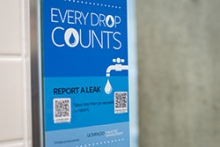 New software developed at UC Merced allows anyone on campus with a smartphone to report water leaks to Facilities in a couple of easy steps.
New software developed at UC Merced allows anyone on campus with a smartphone to report water leaks to Facilities in a couple of easy steps.
Facilities and Operations in mid-March installed quick-response-code stickers in all the restrooms in the Social Sciences and Management (SSM) building.
There are two different QR codes — one for leaky sinks and the other for leaky toilets — individually programmed for each specific restroom.
Users need only scan the appropriate codes with the barcode scanner apps that are on most smartphones. They’ll be asked to log in with their UCMNet IDs and then the scan automatically generates a work request that tells Facilities exactly which restroom it comes from.
Using a login also allows Facilities to follow up with the reporting person in case there are questions about a repair, and to send thank-you notes for helping save water and maintain the campus.
The team behind the “Report a Water Leak” program — Campus Energy Manager Varick Erickson, Facilities’ Director of Energy and Sustainability Zuhair Mased and Facilities’ Director of Operations Jon Lampman — said the goal is to conserve water, increase sustainability and encourage the campus community to participate by reporting leaking water fixtures to Facilities Management.
Erickson developed the QR codes because the process of filling out repair requests was cumbersome, likely preventing some people from reporting leaks at all.
“This is our ‘smart’ way of responding to the drought,” Mased said. “Not only can the software help save water, it can save the campus money and labor.”
The new system is also designed to kick out duplicate requests, which used to have to be sorted manually. Users can track their requests to see that repairs are being made, as well.
Mased and Erickson chose the SSM building for the software’s debut because the building, while smaller than Science and Engineering 1, was the subject of almost as many leak reports last year — about 200.
Eventually the QR code stickers could be programmed to specify exactly which toilet or which faucet has problems, and the plan is to deploy the QR codes across campus, in every place with a faucet or toilet, including labs and showers.
They plan to use the system in SSM for a few months, then survey building occupants to see how it’s going. Erickson and Mased hope users will offer feedback on the system so they can make adjustments before installing the stickers in other buildings.
Once the system is fine-tuned, there’s no shortage of other applications.
“We’d like to use this system for all kinds of things that might need repairs, from burned-out lights to broken chairs and desks,” Mased said.